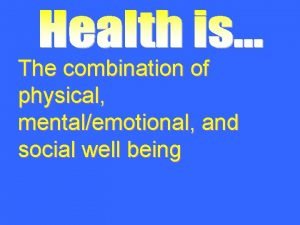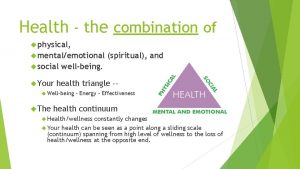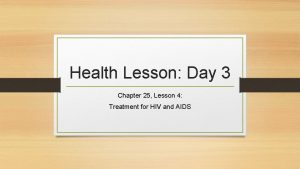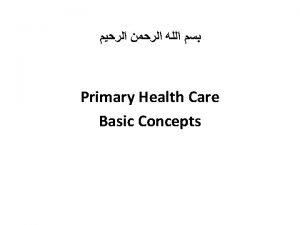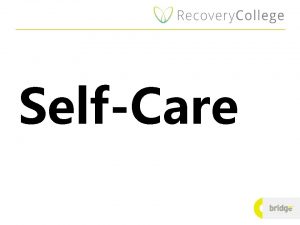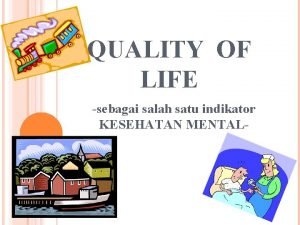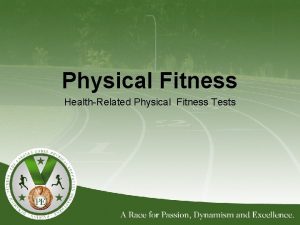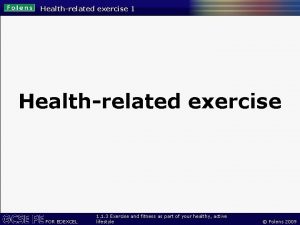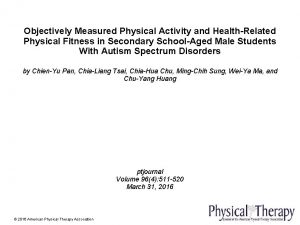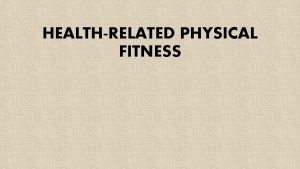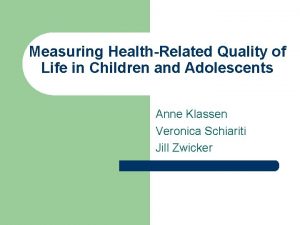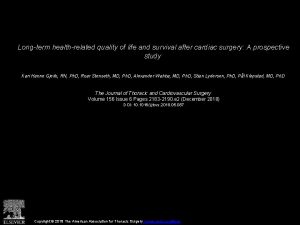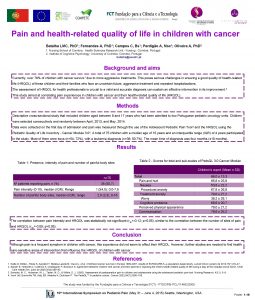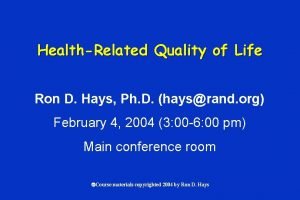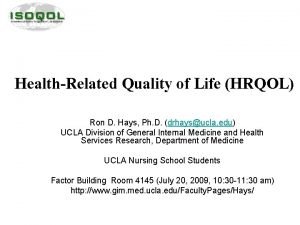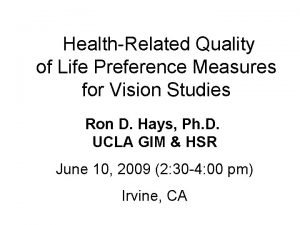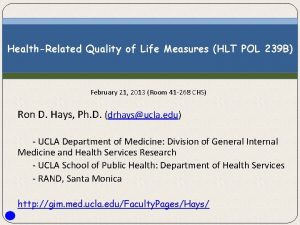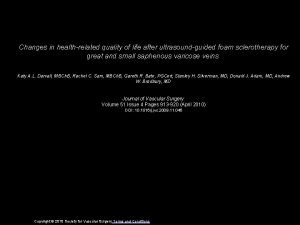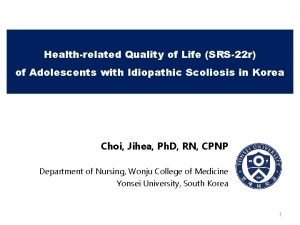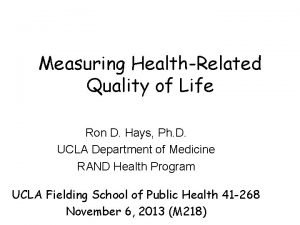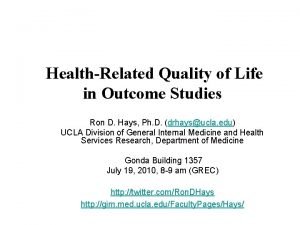Healthrelated quality of life and physical mental and
























- Slides: 24

Health-related quality of life and physical, mental, and cognitive disabilities among nursing home residents in Jordan Zhao Meng 2016, 08, 24

Qual Life Res

Contents Background Methods Result Discussion

Background v Nursing home residents experience a variety of problems that may affect quality of life ---physical disabilities, mental disabilities, cognitive disabilities, self-neglect, and lack of social and financial support and resources. v which of these factors are most closely related to resident QOL v effectively tailor interventions.

Background v Physical, psychological, social, and environmental factors are considered to be the most important indicators of QOL v Increasing life span and the growing percentage of older adults have forced policy makers and researchers to pay attention to quality of life in the aging population. v Both old and young people who are not able to live on their own for medical, financial, social, or cultural reasons. v These nursing homes provide the following services: meals, housekeeping, medication assistance, bathing, and other personal care needs, general medical care. do not offer mental health services, rehabilitation services, or allied health services for their residents.

Background v physical, psychological, environmental, and social quality of life Scores were in the middle of the 5 -point scale, ranging from a low of 2. 44 for social relationships to a high of 3. 04 for environmental factors v only age and length of stay had an impact on quality of life

Background Purpose v. Describe nursing home residents in Jordan in terms of physical, psychological, and cognitive variables. v. We were interested in the possible impact of these variables on an individual’s judgment of their quality of life.

Methods v Design a cross-sectional, descriptive-correlational survey 290 residents (11 nursing homes) 32( mental retardation or severe dementia ) 36(refused to participate) 221((76. 2 % of the total residents)

Methods v Instruments Demographic information (age, gender, education level, marital status, monthly income, previous occupation, smoking habits) Medical history (chronic conditions and medications) MMSE ≥ 26:normal cognition ≥ 27:normal cognition GDS ≥ 10:depressive symptoms ≥ 11:depressive symptoms TAB DASH HRQOL 14 items of the CDC-HRQOL questionnaire: 8 general health : poor, fair, good, very good, and excellent.


Methods v The TAB • an individual’s gait and balance(perform specific tasks, 10– 15 min) • three-point ordinal scale a range of 0(most impairment)– 2(independence) for each item • gait component (12 points) balance component(16 points) • total score is 28 points • ≤ 19 : falls and have balance and gait impairments www. themegallery. com LOGO

Methods v The DASH • upper-extremity disability and symptoms • a 30 -item disability symptom scale • 0 (no disability) to 100 (maximum disability)

Methods v Data processing and statistical analysis multivariate logistic and linear regression analyses using the backward method

62. 4± 13. 9 Results

Results

Results



Discussion v physical, cognitive, and psychological disabilities HRQOL v The possible factors related to HRQOL in this population were the extent of upper limb disability, gait and balance problems, cognitive impairments, depression, and level of education.

Discussion v Madrid(马德里) additional chronic conditions, impaired cognitive function, physical disability, and the presence of depression v Netherlands(荷兰) depression, the presence of psychiatric disorders, and cognitive impairments v Turkey (土耳其) physical abilities and residents’ satisfaction with nursing homes.

Discussion v providing psychosocial interventions and physical and occupational rehabilitation services improving health-related quality of life v addressing depression directly may also have a positive impact on quality of life. v Future research might address the question of which approach (physical or psychosocial) has the greatest impact on quality of life.

Discussion v Cognitive function as measured by the MMSE was also shown to be related to HRQOL among nursing home residents v Improving independence in activities of daily living has a positive effect on the quality of life of persons with cognitive impairments

Limitations First, the nursing home population in Jordan is different from most North American or European nursing homes. Second, has to do with the cut-off scores we chose for identifying normal and impaired scores on the MMSE and GDS. Third, backward entry method: increase Type I error rates.

LOGO
 Pqli advantages and disadvantages
Pqli advantages and disadvantages Mental health and mental illness chapter 20
Mental health and mental illness chapter 20 Mental health jeopardy questions
Mental health jeopardy questions What are the extremes of intelligence ap psychology
What are the extremes of intelligence ap psychology Combination of mental physical and social qualities
Combination of mental physical and social qualities A combination of physical, mental, and social well-being.
A combination of physical, mental, and social well-being. A state of complete physical mental and social well-being
A state of complete physical mental and social well-being Chapter 25 lesson 2 health
Chapter 25 lesson 2 health Health is a state of complete physical
Health is a state of complete physical Quality control and quality assurance
Quality control and quality assurance Basic quality concepts
Basic quality concepts Self care action plan
Self care action plan Quality control vs quality assurance pmp
Quality control vs quality assurance pmp Pmp gold plating
Pmp gold plating Quality assurance model in nursing management
Quality assurance model in nursing management Compliance vs quality
Compliance vs quality David a garvin 8 dimensions of quality
David a garvin 8 dimensions of quality Quality is free
Quality is free Old quality vs new quality
Old quality vs new quality The metropolis and mental life summary
The metropolis and mental life summary Price fences marketing
Price fences marketing Physical fitness grade 9
Physical fitness grade 9 Quality of life adalah
Quality of life adalah Quality is a way of life
Quality is a way of life European quality of life
European quality of life




